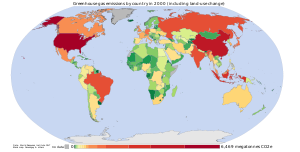 Image via WikipediaHow urban societies can adapt to resource shortage and climate change (22 page pdf, David Satterthwaite, Phil. Trans. R. Soc. A (2011) 369, 1762–1783, May 2011)
Image via WikipediaHow urban societies can adapt to resource shortage and climate change (22 page pdf, David Satterthwaite, Phil. Trans. R. Soc. A (2011) 369, 1762–1783, May 2011)Also discussed here: How urban societies can adapt to resource shortage and climate change (Urban Health Updates, May 23, 2011)
The focus today is on an analysis of greenhouse gas emissions in cities and how they can be reduced while maintaining a high quality of life. One suggestion is to change the way emissions are counted from where they are produced to where or by whom they are consumed- the result is a higher focus on high well-to-do consumers and on what consuming changes are warranted. Also, large compact or dense cities are seen to have higher potential for GHG emission reduction than rural counterparts through more efficient means of transport.
Key Quotes:
“urbanization can be seen as one of the key drivers of high levels of resource use and waste generation that have serious ecological consequences locally (within and around urban centres), regionally (where resource and waste flows from urban centres shift to the wider region) and globally (for instance in regard to climate change and in the reduction in the ozone layer)”
“local, regional and global ecological consequences are not so much driven by urbanization as by the rapid increase in consumption levels and in the number of people with high-consumption lifestyles”
“Dense cities have great potential for limiting the use of motor vehicles (and the associated use of fossil fuels, the generation of air pollution and GHGs)..most large cities have problems with congestion and motor-vehicle-generated air pollution but these are problems that can be addressed.”
“Dense cities allow many more journeys to be made by walking or bicycling, and they make a greater use of public transport and a high-quality service more feasible”
“the percentage [of GHG emissions] generated by transport varies from 11 to 59 per cent..It is generally the higher density cities that have the lower proportions; the North American cities have among the highest levels of transport energy per person, the highest GHG emissions per person and the lowest densities”
“urban areas can combine high living standards with relatively low GHG emissions and lower resource demands …cities can allow high living standards to be combined with levels of GHG emissions that are much lower than those that are common in affluent cities today”
“For London, a shift from production- to consumption-based accounting for GHG emissions increases the average Londoner’s responsibility for GHG emissions from 6 to 12 tonnes of CO2e a year”
Related articles
- How urban societies can adapt to resource shortage and climate change (urbanhealthupdates.wordpress.com)
- Does Better Urban Design Beat Better Car Design when it comes to Emissions? (pollutionfree.wordpress.com)
- Urban Vulnerability to Climate Change (pollutionfreecities.blogspot.com)

No comments:
Post a Comment